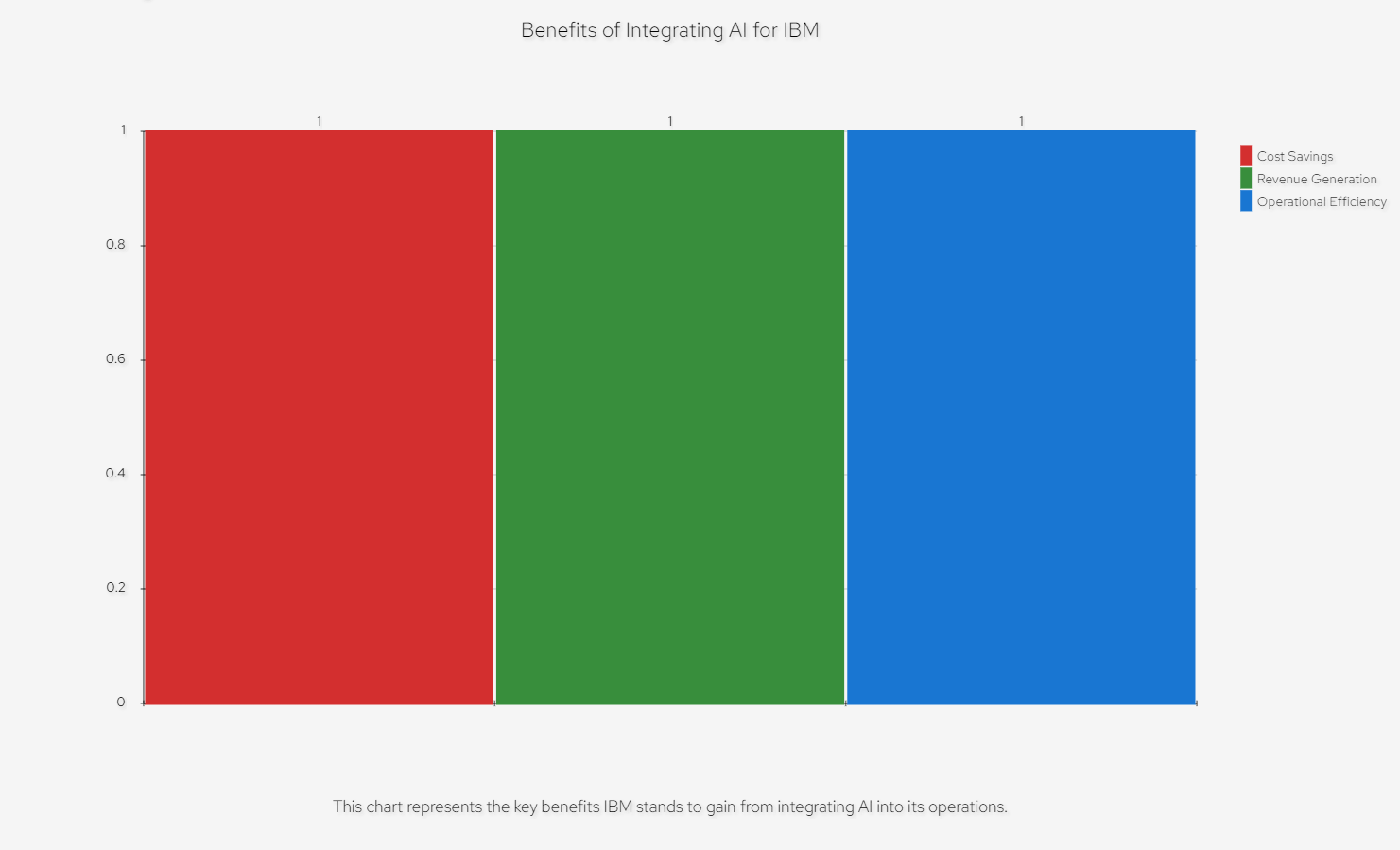- 30 August 2023
- No Comment
- 231
Dramatic Pivot: IBM Sees AI Replacing 50% of Employees

IBM’s Visionary Shift: AI’s Promise of Profitability and Efficiency
Buckle up! IBM’s CEO just made a move that has the entire tech world buzzing.
Welcome to another informative blog, I am Nabeel Shaikh, a seasoned Chartered Accountant with over 17 years of diverse experience in investment banking, management consulting, and entrepreneurship.
Remember when we were kids and robots taking our jobs was pure sci-fi? Well, IBM’s head honcho doesn’t just think it’s possible; they’re actively preparing for it. As a result, they’ve put a bold freeze on hiring for tons of back-office roles, essentially putting up a sign that reads, “Robots Only Beyond This Point!”
And if that wasn’t enough, they dropped a bombshell prediction that AI could snatch up to half of all new jobs. It’s a bold, brash statement that has left some thrilled, and others a tad nervous. We’re talking about half the workforce possibly getting a “robotic upgrade”.
But this is not just idle speculation; it’s a strategic move backed by a massive investment. They’ve just funneled a ton of cash into a tech unicorn’s monstrous $235 million funding round. For those scratching their heads, that’s a cool $4.5 billion valuation for a company many hadn’t even heard of till now.
It’s clear, IBM is not just forecasting the AI revolution, they’re driving it. With that kind of money in play, they’re betting on this unicorn to be a major player.
The CEO’s Strategic Acumen
IBM’s CEO, renowned for his visionary mindset, has prominently emphasized AI’s pivotal role in IBM’s future roadmap. The decision to halt hiring for a broad range of back-office jobs points towards a sweeping move towards automation. Furthermore, his assertion that AI could account for nearly 50% of new job roles in the upcoming years serves as a profound forecast and a clarion call to the global corporate ecosystem.
However, this is not just a visionary statement; it’s a concrete action that reflects IBM’s confidence in AI’s capabilities and potential. Therefore, further accentuating this vision, IBM’s monumental financial foray into a tech unicorn, boosting its valuation to an impressive $4.5 billion, mirrors the financial optimism surrounding AI’s transformative prowess.
IBM’s Financial Forecast: The AI Dividend
IBM’s pursuit of AI isn’t just about pushing the innovation envelope; it manifests as a blueprint for exponential cost savings and robust revenue generation. Through the automation of back-office functions, IBM is poised to achieve significant reductions in expenses linked to salaries, benefits, and operational overheads. Beyond this, AI’s potent predictive analytics, efficient data processing, and swift task execution can refine and expedite operations, further trimming operational expenditure.
Additionally, with an augmented AI-centric product lineup, IBM is strategically positioned to tap into emerging revenue streams. As industries increasingly gravitate towards AI solutions, IBM, equipped with its broadened offerings, is well-placed to serve this burgeoning demand, potentially catapulting its revenues.

AI’s Broader Economic Implications
IBM’s strategic blueprint offers a revealing insight into the immense possibilities AI presents to the broader business world. By automating monotonous tasks, diverse industries stand to achieve substantial cost savings. For instance, in finance, AI can seamlessly manage transactions and projections, while in healthcare, AI can significantly enhance diagnostic accuracy. The economic advantages are undeniable. Businesses stand to benefit from minimized human errors, continuous operational capabilities, and accelerated task completion, fortifying their profitability metrics.
In addition, the vast potential of AI isn’t limited to cost containment. For businesses, AI unfurls opportunities for pioneering products, bespoke customer experiences, and streamlined supply chain operations. Such enhancements can significantly propel revenue growth, ensuring businesses realize significant returns on their AI investments.
The Job Landscape: Challenges and Opportunities
AI’s promise of operational efficiency comes with intricate implications for employment dynamics. While monotonous roles, predominantly in back-office functions, are the most apparent targets for automation, AI’s expanding sophistication suggests its influence will permeate specialized roles across sectors, including finance, healthcare, and even creative fields.
However, historical precedent reminds us that while technological advancements may phase out specific roles, they concurrently pave the way for new professional avenues. AI will undeniably demand a new breed of professionals adept at designing, maintaining, and refining these systems. Moreover, professions necessitating profound human insights, unparalleled creativity, and deep-seated empathy are likely to endure and might even gain from AI integrations.
The Gig Economy and Reskilling: Hope in Change
AI’s ascent could herald a renaissance for the gig economy. Freelancing, consultancy roles, and specialized entrepreneurial endeavors might witness exponential growth as traditional job roles undergo metamorphosis. For those contemplating potential job transitions, the emphasis must unequivocally be on perpetual learning and adaptability. Initiatives centered on upskilling and reskilling, steered by corporates, educational institutions, and governments, will become paramount.
Lessons from IBM’s Big AI Bet: Tips for Businesses
IBM’s strategic play in the realm of Artificial Intelligence (AI) speaks volumes about the tech titan’s vision for the future. Their aggressive stance, which involves preparing for a workforce that incorporates AI in a significant manner, is not just a show of strength but a template for success in the impending AI-first world. For businesses watching from the sidelines, there are many lessons to be gleaned. Here are a few:
Embrace Change, Don’t Resist:
The most apparent takeaway from IBM’s move is the necessity to accept technological advancements. Companies must view AI not as a threat but as an ally. Modern problems need modern solutions, and AI offers a toolbox brimming with possibilities.
Invest in the Right Ventures:
IBM’s investment into a tech unicorn with a towering valuation underscores the importance of being discerning. Not every AI startup or solution is worth your penny, but by researching, businesses can find ventures that align with their goals.
Preparation Over Panic:
Instead of scrambling at the last moment, companies should foresee the shift, just as IBM did. A proactive approach towards integrating AI, from staff training to updating infrastructures, will be more cost-effective and smooth in the long run.
Diversify Skill Sets:
The prediction that AI might replace many roles doesn’t mean human roles will become obsolete. There’s an opportunity here for businesses to encourage their employees to develop multifaceted skill sets that AI can’t replicate – like emotional intelligence, creativity, and complex problem-solving.
Prioritize Ethical AI:
One thing IBM has been clear about in the past is the importance of ethical AI. As businesses incorporate AI, ensuring that algorithms are unbiased and ethical not only safeguards brand reputation but also ensures long-term sustainability.
Stay Updated with Trends:
The AI realm is dynamic. From breakthroughs in neural networks to quantum computing leaps, it’s vital for businesses to be on top of these developments. This doesn’t mean jumping onto every bandwagon but understanding which trends could impact or benefit one’s industry.
Redefine Roles, Don’t Just Eliminate:
It’s essential to recognize that while AI will automate tasks, it also presents a chance to redefine roles. Instead of merely eliminating positions, restructure them. Create teams that synergize human creativity with AI efficiency.
Focus on Customer Experience:
IBM’s pursuit indicates a future where AI facilitates better user experiences. Companies should explore how AI can enhance their customer’s journey, from chatbots for 24/7 support to predictive analytics offering personalized shopping experiences.
Data is Gold:
If there’s one thing that fuels AI, it’s data. But not just any data—clean, organized, and meaningful data. Businesses must invest in robust data management systems and practices. The better your data, the more effective your AI.
Collaborate and Partner Up:
No company is an island in the AI age. Form partnerships, join industry consortiums, or collaborate with academia. IBM’s partnership with the tech unicorn shows the value of collaboration in achieving bigger goals.
IBM’s audacious move is not just a story of a tech giant flexing its muscles. It’s a roadmap for businesses in the age of AI. As we hover on the brink of what promises to be a transformative era, the message is clear: evolve, embrace, and excel. Businesses that take a leaf out of IBM’s book today might very well be the success stories of tomorrow.
Technical side of AI
Now, let’s delve deeper into the technical side of AI and how businesses can harness its power. Here are some more advanced lessons that other businesses can draw from IBM’s audacious move:
Infrastructure Readiness:
Before deploying AI, ensure your IT infrastructure is robust and scalable. This includes considering cloud storage, efficient processing units like TPUs or GPUs, and high-speed network connectivity. A strong foundation ensures smoother AI integration.
Neural Network Varieties:
Understand that not all neural networks are created equal. Depending on the business need, you might require Convolutional Neural Networks (CNNs) for image recognition, Recurrent Neural Networks (RNNs) for sequence prediction, or Transformer architectures for natural language processing.
Quantum Computing:
IBM has been pioneering quantum computing. Quantum computers can solve specific problems exponentially faster than their classical counterparts. As this technology matures, businesses could harness quantum algorithms to optimize AI processes.
Transfer Learning:
Instead of training an AI model from scratch, use pre-trained models and fine-tune them for specific tasks. This approach, known as transfer learning, can save time and resources while delivering efficient results.
Federated Learning:
Privacy is a significant concern in the AI world. Federated learning allows you to train AI models on decentralized data, ensuring user data remains on their device, addressing privacy concerns and regulations.
Explainable AI (XAI):
As AI models become more complex, their decision-making processes can become opaque. Investing in XAI ensures that these decisions are transparent and can be understood by humans, fostering trust and easing regulatory concerns.
AutoML and Neural Architecture Search (NAS):
Allow AI to design better AI. These tools can automate the process of selecting the best machine learning model architectures, saving time and often leading to superior performance.
Edge AI:
Instead of centralizing AI in data centers, push AI computations to the edge (like mobile devices or IoT devices). This can reduce latency, save bandwidth, and enable real-time insights.
Robustness & Security:
AI models can be vulnerable to adversarial attacks, where malicious inputs can deceive the model. It’s crucial to incorporate security measures and test AI robustness against potential threats.
Continuous Learning & Evolution:
AI isn’t a one-off project. Models can drift over time as data changes. Therefore, implementing a continuous learning system ensures that AI models adapt and evolve, maintaining their accuracy and relevance.
On the other hand, the deep dive into AI’s technical aspects shows that while the field is intricate and ever-evolving, the potential benefits for businesses are vast. By understanding and integrating these technical facets, businesses can ensure they’re not just adopting AI but are at the forefront of its innovative surge.
Conclusion
IBM’s CEO, with his emphatic endorsement of AI, sketches a captivating vision of the future—one where AI underpins profitability and reimagines the employment sector. As industries converge at this AI inflection point, their strategic decisions will not only shape their fiscal journey but also profoundly influence the global workforce’s evolution.
Please share this with your friends and followers. And if you have any questions or comments, leave them below. I would love to hear from you. Don’t miss out and subscribe to NashFact.com today.



